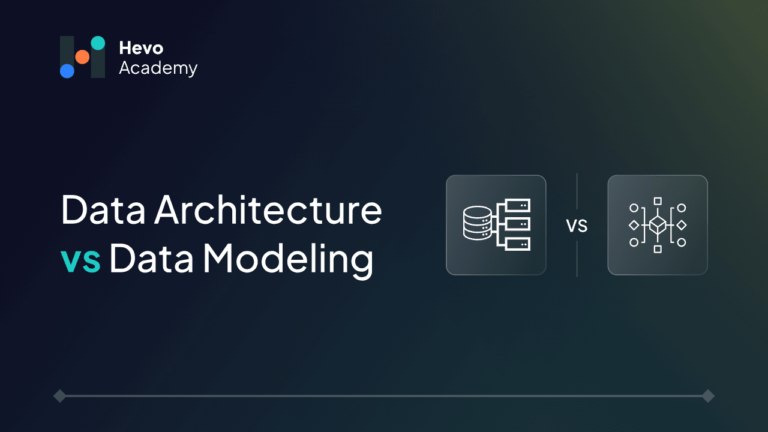In today’s data-driven world, organizations rely heavily on structured systems in order to manage, analyze, and utilize data effectively. Two fundamental concepts in this domain are data architecture and data modeling. Even Though they have some differences, they still play an important role. While they often intersect, each plays a distinct role in shaping an organization’s data infrastructure.
Table of Contents
This blog discusses an overview of data modeling and data architecture, three levels of data modeling, data architecture vs data modeling, the importance of data modeling in data architecture, and ways to effectively combine data modeling in data architecture.
Data Modeling Overview
The process of developing a graphic representation of the data that is stored and controlled by data architecture elements and policies is known as data modeling. It provides a conceptual depiction of data objects, showing how various data points relate to one another and the laws that govern them. It facilitates the enforcement of government policies, compliance laws, and company norms, as well as the visual description of data.
Specialized data modeling software is typically used to accomplish data modeling. This makes the final product more readable and accurate by ensuring consistency in naming conventions, default values, and semantics. Relational tables can then be defined using the data model’s representation, and primary and foreign keys can be created to specify the connections between data in various tables. Tools such as ERwin and Lucidchart are often used in this process.
Levels of Data Modeling
There are three levels of data modeling, as mentioned below:
1. Conceptual Data Modeling:
This model shows design at a high level. It shows the significance of data and where the data will be stored. The audience of conceptual data modeling includes analysts and business stakeholders. For example, An entity-relationship (ER) diagram shows entities like products, orders, and customers and the relationship among these entities: “A customer made a new order of ten products.”
2. Logical Data Modeling:
This model shows the details of attributes, characteristics, and relationships between various entities. Basically, it provides abstraction without providing any details of physical implementation. The audience of logical data modeling includes database designers and developers. For example, associating attributes of each entity of a customer, such as first name, last name, and a customer number, as well as linking the customer to a specific order that includes details like order number and product details.
3. Physical Data Modeling:
This model focuses on the actual implementation details that are specific to the storage framework and application used for that data. The audience of physical data modeling includes engineers and database administrators. For example, the SQL table creation scripts and data partitioning.
Data Architecture Overview
The production, design, deployment, and administration of an organization’s data are all covered under the comprehensive field of data architecture. It is made up of models, rules, standards, and policies that regulate the gathering and storing of data. Data architecture can be thought of as the plan for managing data throughout the company and making sure that the data that is gathered and stored is consistent and free of redundancies.
Data models, data integration, data storage, and data governance are just a few of the many elements that make up data architecture. Depending on the organization’s objectives, the architecture’s specifications can vary greatly, but its main objective is always to make data utilization more efficient.
There are three types of data architecture:
- Enterprise data architecture: It aligns data strategies with overall business policies and goals
- Solution data architecture: It focuses on the architecture that is needed for specific systems
- Application data architecture: It addresses the data layer and integration within specific applications.
Difference Data Architecture vs Data Modeling
| Data Architecture | Data Modeling |
| Data Architecture is basically a high-level framework for data management. | Data Modeling provides the blueprint for database design. |
| It focuses on the integration of systems and processes. | It focuses on the structure and representation of data. |
| The scope of data architecture is broad and covers the entire data ecosystem. | The scope of data modeling is specific to the data layer or database. |
| Its key deliverables include architecture design and data flow diagrams. | Its key deliverables include schema definition and ER diagrams. |
| Some of the tools that are used for data architecture are IBM Infosphere Data Architecture and AWS Well-Architected tool. | Some of the tools that are used for data modeling are Lucidchart, SQL Database Modeler, and ERwin data modeler. |
Data Architecture vs Data Modeling: Key Differences
There are some clear differences between data architecture vs data modeling. Some of them are mentioned below:
- Data architecture has a macro perspective, while data modeling has a micro perspective.
- If we consider the scope of these two, data architecture is about the big picture. It tells about what the overall data system should look like. On the other hand, data modeling is more specific as it creates detailed designs of datasets to tell how data should be structured.
- Data architects think about strategy, design, and plan the entire data system while on the other hand, Data modelers focus on the details of the data.
- Data architecture involves picking storage tools, setting up systems, and creating rules for how data is managed. Data modeling is about drawing diagrams to show how data is related and organized, using tools like entity-relationship diagrams (ERDs).
- Data architecture is more about planning and creating a framework for the entire organization’s data, while data modeling defines how tables and data points are designed.
Importance of Data Modeling in Data Architecture
Even though there are some differences between data modeling and data architecture, they still complement each other.
- Data architecture focuses on establishing a strong framework that covers data organization, usage, and data processing. Its scope covers the entire data ecosystem and focuses on higher levels of data tools and platforms as well as guidelines, rules, and standards for processes and policies for data management. Data modeling focuses on providing structure and representation of data via schema and diagrams inside data architecture. Its goal is to cover the content, structure, and details of data assets.
- In addition to serving as the foundation for creating business data storage, availability, and security policies, well-defined data models also help the data architect choose the right platforms, tools, and technologies. The work of the data modeler is made easier by an established data architecture, particularly when adequate tools and best practices are offered to clarify the definition and attribution of business data concepts.
- Badly constructed data models can harm your company and result in serious analytical failures. Both the correct data and the significance of the data you have for your business will be impossible to find. If your data models aren’t working properly, you run the risk of making decisions based more on assumptions and intuition than on facts.
How to Effectively Combine Data Architecture and Data Modeling
Data architecture and data modeling both play important roles in effective data processing, usage, and management.
- While data architecture provides a high-level framework and strategy for data usage, data modeling provides the key details to implement this strategy effectively.
- An organization frequently must use data architecture and data modeling strategies together to make the use and management of data more effective and efficient.
- Together, both of these ensure that storage, organization, processing, and usage are efficient and effective.
- A strong data architecture provides the framework, strategy, and direction for data usage across the organization. Within this framework, data modeling provides further details, like how the data is stored, organized, and used within the specific databases. The data modeling practices ensure that the data architecture is implemented constantly across the organization.
Conclusion
The process of developing a model that represents the enterprise’s data is known as data modeling. In addition to defining rules, default values, and naming conventions, this model includes the business concepts and their relationships. Conversely, data architecture refers to the whole infrastructure that houses the data and data models. By developing the environment for the data in terms of tools, platforms, and solutions, data architects aim to keep the data secure while still making it easily available. Understanding both of these concepts and their importance allows organizations to have better data strategies and improved decision-making. As data keeps on growing, businesses continue to rely on it, and mastering these principles is becoming more important.
Hevo offers an intuitive platform for seamless data integration, ensuring data security and accessibility while simplifying complex workflows. Sign up for a 14-day free trial and experience the feature-rich Hevo suite firsthand.
FAQs
1. What is the difference between a data model and a data structure?
A data model is a representation of data elements and their relationship. It focuses on conceptual understanding and design. On the other hand, data structure is the organization of data in memory or storage, such as trees, arrays, hash tables, or LinkedIn lists.
2. What are the three types of data architecture?
The three types of data architecture include Enterprise data architecture, solution data architecture, and application data architecture. Enterprise data architecture aligns data strategies with overall business policies and goals. Solution data architecture focuses on the architecture that is needed for specific systems. On the other hand, application data architecture addresses the data layer and integration within specific applications.
3. Is data modeling part of data architecture?
Yes, data modeling is part of data architecture as it designs structure, rules and relationships within the datasets that are crucial for implementing the overall architectural framework effectively.
4. What is the difference between data modeling and schema?
Data modeling is the process of designing rules and abstract relationships of a dataset. On the other hand, the schema is the actual implementation of this design in a database, detailing tables, fields, and constraints.





